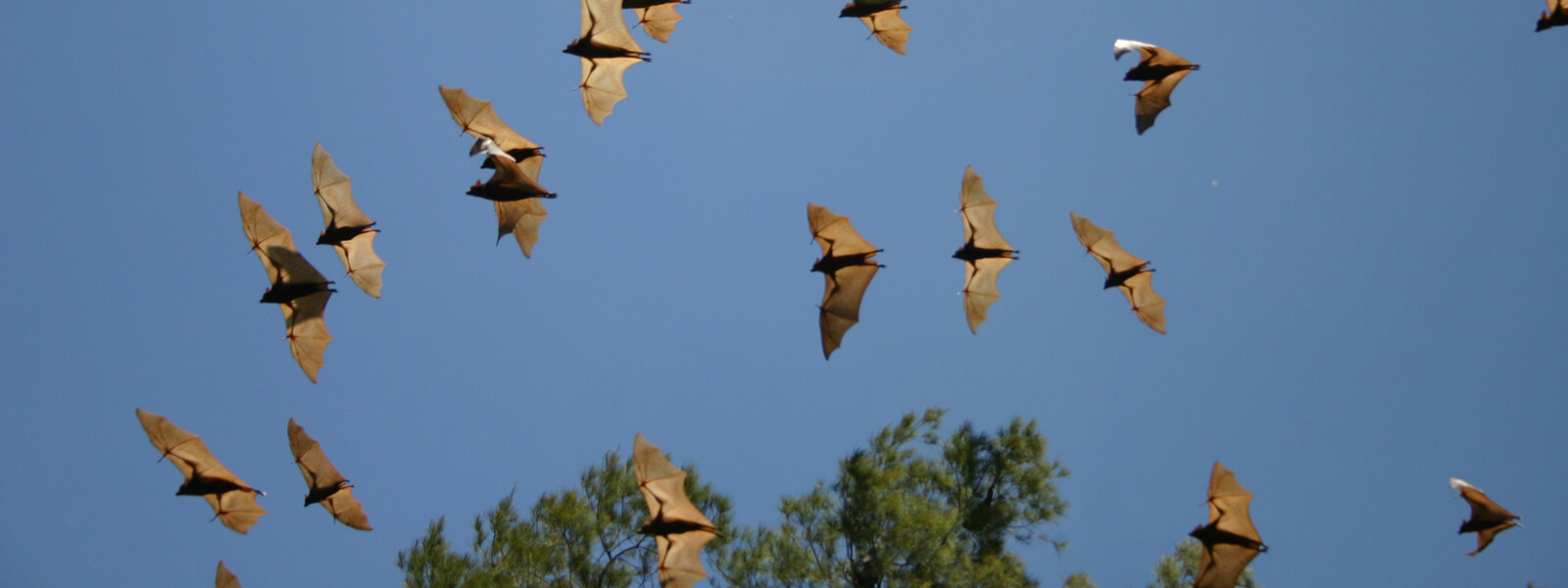
The bat-virus détente
For several weeks in March, Arinjay Banerjee would eat breakfast at 6 a.m. and then drive the empty roads of Toronto to a restricted-access lab. Then he’d ready himself for work, donning three layers of gloves, a helmeted mask kitted with an air-purifying respirator, and a surgical-style gown.
The interlocked doors and special filtered ventilation system of the lab, fitted with alarms should air circulation malfunction, are designed to stop outward air flow. After eight hours at the bench, Banerjee would put aside his scrubs and boot covers for sterilization, change out of his work sneakers and return to a basement apartment in the home of a colleague.
The stringent conditions in that Toronto lab — only one level below the most secure in the biosafety hierarchy — were crucial. Banerjee, a virologist, was on a team working to isolate the SARS-CoV-2 virus from one of the first patients in Canada. As the pandemic unfolded, he almost felt safer suited up in the containment lab than he did when out in the world.
The team was pushing to isolate the virus so they could get a jump on vaccine development. Banerjee was the bat guy. He had expertise in biosafety lab work and experience in isolating dangerous pathogens. He had studied how bats interact with viruses like the one that causes MERS, one of hundreds of coronaviruses that the mammals can harbor.
Bats have become newly infamous as reservoirs of deadly viruses. In addition to hosting an ancestral version of the MERS virus, which has caused repeated outbreaks in people, bats also harbor very close relatives of the ones that caused the 2003 SARS outbreak and today’s Covid-19 pandemic. They are natural hosts for Hendra, Nipah and Marburg viruses — all of which can be deadly in people — and they are the suspected reservoir of the Ebola virus that has killed thousands in multiple outbreaks in Africa.
Bats can also host a diverse range of influenza viruses as well as relatives of the human-infecting hepatitis C virus. And research suggests that some viruses that today infect only people, like measles and mumps, had their evolutionary origins in bats.
Yet despite the long list of bat-dwelling viruses, the animals don’t seem to be bothered by their many invisible inhabitants. And scientists want to know why. Today, a growing number of them suspect that the key lies in special features of the bat immune system — ones that spark responses to viral invasion that are very different from what goes on in people. “It’s very intriguing,” Banerjee says. “I wake up thinking about it every day. Why do bats have this immune response that’s so different from ours and so different from other mammals?”
Of course, many viruses exist in wildlife, often causing little harm to their natural hosts and only making trouble for us when they manage to jump to human beings or other creatures with which they don’t share a long evolutionary history. Ducks and other water birds muck about while carrying myriad strains of influenza A; pigs aren’t fazed by hosting hepatitis E. But bats appear to be special, if only in the number of high-profile viruses that they carry and appear to tolerate.
Before Covid-19 came along, scientists already were piecing together some of the peculiarities of the bat-virus relationship. That research has taken on new urgency. And it raises an intriguing possibility. If we better understand how bats tolerate their viral passengers — by stepping up activity of one immune protein, say, or dialing down activity of another — we might better understand how viral infections proceed in people. That, in turn, might point to treatments that could make infections in people less severe.
“Rather than trying to reinvent the wheel, we could learn from what evolution has developed in a bat, where the outcome is not disease but it’s something that enables survival upon infection with a particular virus,” says cellular immunologist Judith Mandl of McGill University in Montreal. “If we figure that out, then maybe we can apply the same principles and modulate the immune response in humans.”
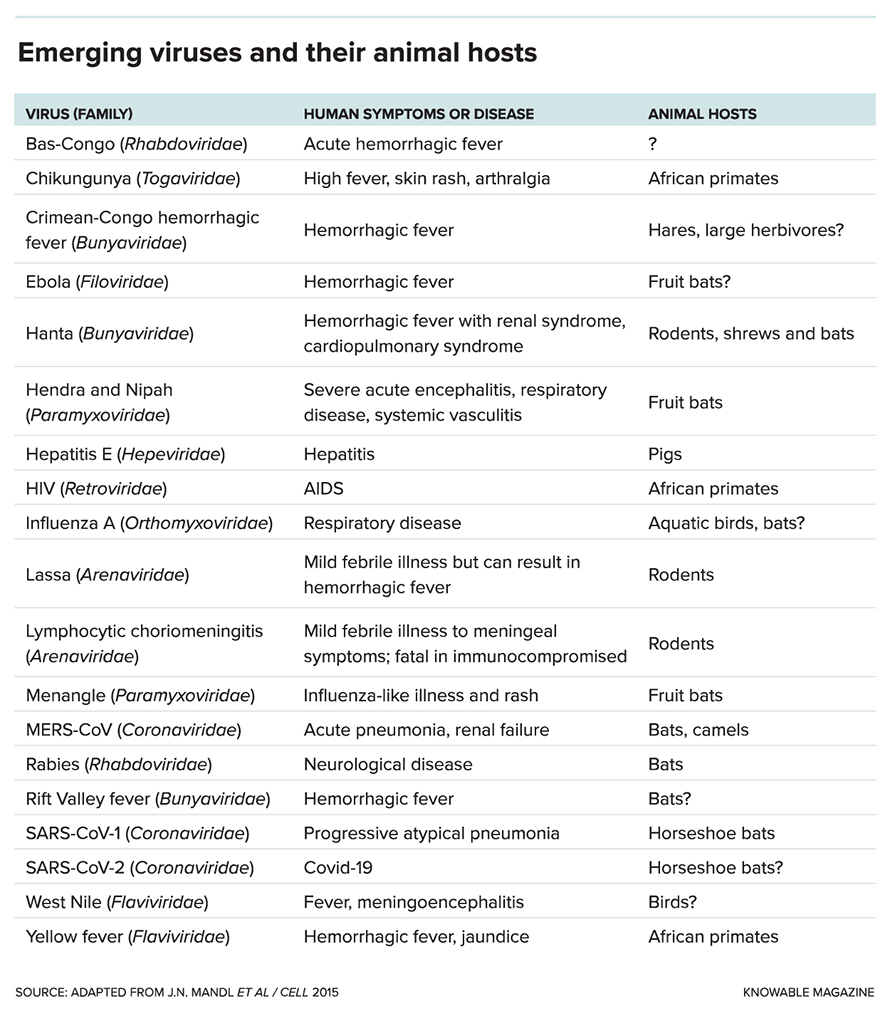
Suppress, then tolerate
The impressive ability of bats to ward off disease has long been remarked upon. A 1932 scholarly note on fruit bats in Australia states, “No reliable evidence of the occurrence of epidemics among the fruit-bat population was discovered.” And a 1957 paper on the southeastern myotis bat notes that “disease is apparently unimportant.... During the course of this study, which involved observations on over a million bats in every known cave colony in Florida, I have never found a dead bat, and have seen only one which appeared diseased.”
Certainly, bats in the United States are in trouble today: The Eurasian fungus behind white nose syndrome has been killing large numbers of many bat species for more than a decade. But with few exceptions — including rabies and the more obscure Tacaribe virus — when bats get infected with viruses they don’t appear to get sick.
“There seems to be no pathology associated with these infections — no clinical signs associated. They can remain in good health and display no discernible signs of disease,” says Raina Plowright, an infectious disease ecologist and wildlife veterinarian at Montana State University in Bozeman who coauthored a new review on bats and viruses.
When a host, whether bat or human, is infected with a disease-causing pathogen, the ensuing interaction is often described as a battle: The host’s immune system pulls out the big guns to fight and eradicate the invader. In immunology parlance, this is known as resistance; its end game is destroying the pathogen.
But there’s a growing appreciation of the importance of disease tolerance, a “keep calm and carry on” approach in which the immune system limits collateral damage to the host but doesn’t worry about getting rid of every trace of a pathogen. And several recent studies suggest that this tolerance model captures how bats interact with many of the viruses they carry.
Many details are missing: There are some 1,300 bat species — they are the second largest order of mammals, outnumbered only by rodents — and studies typically focus on one or a handful. But a rough picture is emerging. Research suggests that the bat immune system deals with marauding viral invaders in two key ways: First, the bats mount a speedy but nuanced offensive that stops the virus from multiplying with abandon. Second, and perhaps more important, they dial down the activity of immune foot soldiers that might otherwise cause a massive inflammatory response that would do more damage than the virus itself.
“Bats have a lot of this good immune response — suppressing virus replication — that protects them,” Banerjee says. “And they have very little of the not-so-good immune response, which is inflammation.”
Key players in this two-part bat immune response are interferons, small signaling molecules that got their name because of their talent for interfering with virus replication. They’re a first line of defense for mammals in general: When cells are infected by viruses, they release various interferons as an alarm signal, as do some immune system cells.
But bats seem to go one better. To start with, some species have an outsize number of genes for making interferons: Large flying foxes (Pteropus vampyrus) and little brown bats ( Myotis lucifugus) have dozens of genes for making even just one kind, called type 1 interferons; the Egyptian fruit bat ( Rousettus aegyptiacus), a natural host of Marburg virus, has 46 (humans have about 20).
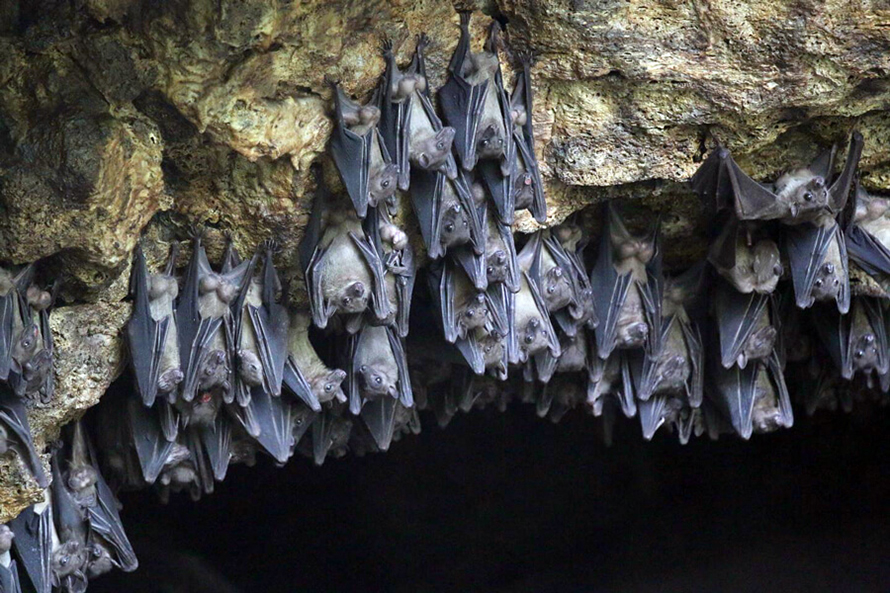
Black flying foxes (Pteropus alecto) seem to use another strategy: In this species — as well as the lesser short-nosed fruit bat ( Cynopterus brachyotis) — some genes for making interferons are always turned on, even when there’s no viral invader to contend with. In the black flying foxes, these “always on” interferons, among other things, kick-start production of an enzyme that chops up viral genetic material.
Black flying foxes and big brown bats (Eptesicus fuscus) have yet another trick up their wings. They have an extra-strong version of a protein whose job is to flip the “on” switch for some interferon genes. Experiments by Banerjee and colleagues using genetically altered human and bat cells found that in either kind of cell, the bat protein was better than the human version at keeping viral numbers down after exposure to a cousin of the rabies virus.
Bats, in other words, seem to have multiple layers of interferon protection: one that stands at the ready to quickly curtail viral replication, and another, more standard-issue one that ramps up activity after a viral invader has appeared. But it’s not just a blunt one-two punch. The sheer number of interferon genes some bats have hints at a flexible, more nuanced response.
Having many, many copies of a gene presents opportunities, says Thomas Kepler, a computational immunologist at Boston University’s medical school, who’s done much of the Egyptian fruit bat research. Some of the genes can ramp up or down their activity even as other ones keep normal functions going. Rather than all of the interferons sounding the standard “prepare for war” alarm, some may tell cells to hold their fire and sit tight.
The message, Kepler says, may be, “We’ve got a virus, let’s use soft power for as long as we can.”
Taming inflammation
A key thing that interferons do in mammals is encourage inflammation. This response is essential for fighting infections, but too much can be catastrophic. Out-of-control inflammation is a common theme in severe illnesses from viruses that have jumped from other species: In people infected with deadly filoviruses like Ebola, for example, a bombardment of inflammation-causing molecules spurs the failure of multiple organs and a septic shock-like syndrome.
Some novel strains of influenza, including the one that caused the 1918 pandemic, are especially adept at triggering a barrage of inflammatory molecules. This prolonged blitz — which can manifest as what’s called a cytokine storm — was also found in people who fared poorly with SARS, and is what kills many of the sickest patients with Covid-19.
“If you get infected with something, the immune response is always walking this tightrope,” says immunologist Mandl. “It’s a balance between making sure the response is vigorous enough — but not so vigorous that, for example, you end up with the lungs filling with fluid and a lot of inflammatory cells.”
Bats, in addition to their tricks for mobilizing interferons, walk this tightrope with finesse. They largely avoid the dangerous inflammation overreaction and seem to have several ways to do so.
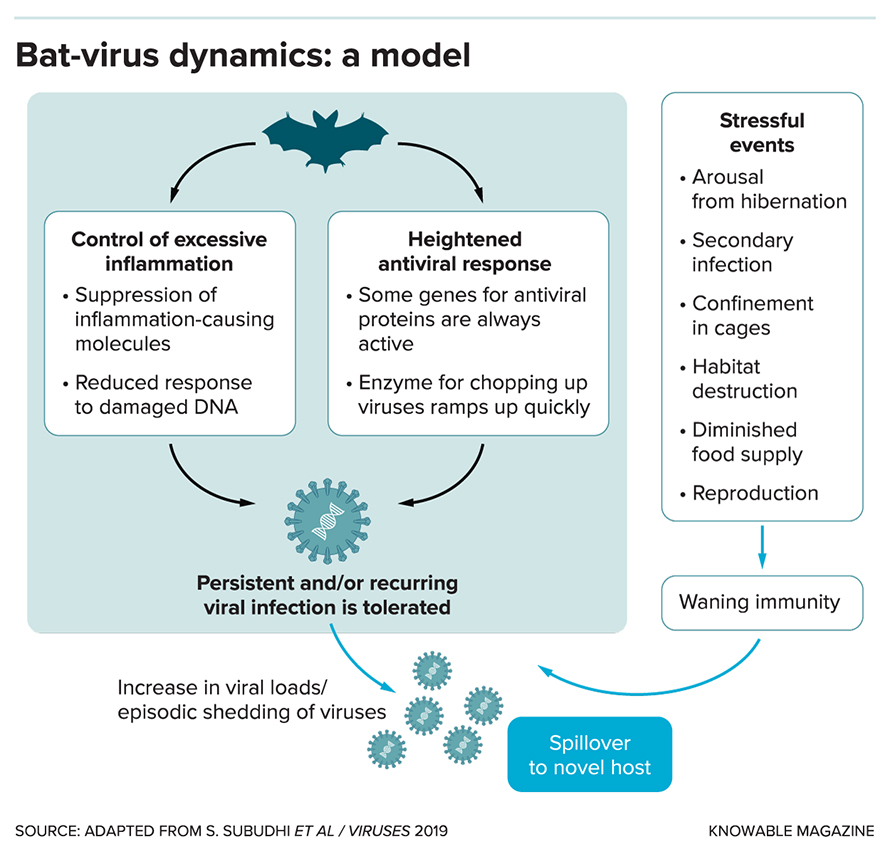
For example, a study of immune cells called macrophages of the greater mouse-eared bat (Myotis myotis) found more production of interleukin-10, a protein known to suppress the body’s inflammatory responses, compared with mouse macrophages when the cells were exposed to chemicals that mimic a virus infection.
And aspects of the genome of the Egyptian fruit bat, published in 2018 in Cell, suggest that bats may subdue immune cells called natural killer cells that can injure bodily tissues if they overreact. Natural killers respond to interferons by hunting and killing virus-infected cells. But bat natural killers have an unusual number of receptors that restrain, rather than activate, the cutthroat response.
The genome paper also reported that some of these “hold your fire” receptors are active in an array of cells and tissues, even in uninfected fruit bats. In other words, noted authors of a commentary — aptly titled “Holy Immune Tolerance, Batman!” — the animals might be primed at all times to mute the ferocity of their natural killer cells.
There are other clues to how bats minimize inflammation. For example, several bat species have a mutation in a protein called STING that senses damaged genetic material, be it from bat or virus. Normally, this would kick off an inflammatory response, but it doesn’t because the sensor is crippled in these bats, reported a team that included Zheng-Li Shi, the Wuhan, China, virologist who first connected Covid-19 to a bat-borne virus.
And recent work suggests that bats can tamp down large protein clusters called inflammasomes. These coordinate the release of all sorts of inflammation-promoting molecules in response to danger signals such as the presence of viral genetic material. They also spur a kind of cell suicide that releases even more inflammatory molecules.
In a study led by virologist Linfa Wang of the Duke-National University of Singapore Medical School, researchers exposed immune cells from people, mice and two bat species to three kinds of virus: influenza A, the MERS coronavirus and one called the Melaka virus. Inflammasomes in the mouse and human cells responded with vigor. But the bat inflammasome activity was quashed, the team reported in Nature Microbiology last year.
Finally, at least 10 species of bats have lost an entire family of proteins — the PYHIN family — that sense danger and activate inflammasomes. Typically these sensors would trigger assembly of inflammasomes after encountering little bits of cellular DNA, whether foreign (indicating an invader) or self (indicating damage).
Add it all up, and bats “really seem to throttle inflammation,” says evolutionary biologist Emma Teeling of University College Dublin, cofounder of a major effort to explore bat genomes.
Better living through flying
As researchers parse how bats coexist with so many viruses, they are also asking why the creatures are this way. What is it about their evolutionary trajectory that led to such tolerance of dangerous-to-people pathogens, compared with other animals? The answer may seem surprising: The tolerance could be connected to the fact that bats fly.
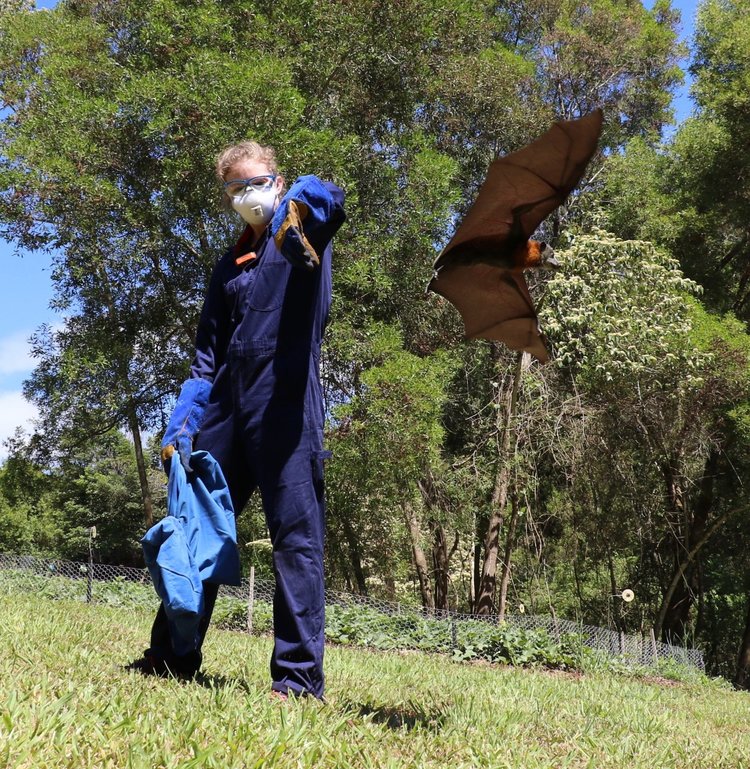
in Australia. Kessler is studying how habitat loss and other factors affect the risk of Hendra virus transmission from this and related bat species.
Bats are the only mammals capable of sustained, powered flight (they don’t just glide), a feat that has required not just changes in anatomy but changes in metabolism as well. Flight is a major workout — it is estimated that a bat’s metabolic rate can increase to up to 34 times over its resting level when it takes to the air. By comparison, rodents running to exhaustion exhibit an eightfold increase, and birds on the wing a doubling.
Though the data are still fairly scant, scientists have a couple of hypotheses that link these two apparently disparate things — flight and tolerance to viruses. One version goes something like this: The uptick in bat metabolism during flight mimics the fever that occurs in other animals when their immune systems are fighting viruses. So for bats, dealing with viruses may be trivial because they are already dealing with flight.
The other hypothesis centers around the ramped-up metabolic activity that comes with flying: It generates all kinds of damaging chemicals called reactive oxygen species that can shred cellular machinery and important molecules such as DNA. Sustained oxidative stress can also trigger inflammation, which contributes to all sorts of maladies in mammals.
Bats altered their physiology to deal with this stress, and some of the changes had spin-off effects.
A survey of the genomes of black flying foxes and the David’s myotis, for example, revealed a surprising number of genes related to DNA repair. And the loss of those damage-sensing PYHIN proteins may also help keep them from overreacting to DNA damage through inflammation.
Those tamped-down responses, originally tailored for dealing with flight, mean that bats may also escape the dangerous collateral damage of viral infections, says disease ecologist Cara Brook, a postdoctoral fellow at the University of California, Berkeley.
The hypothesis is appealing because it speaks to another odd feature of bats: They have extraordinarily long lives. Generally, lifespan is correlated with body size, and large animals live longer than small ones. But bats defy that rule. Aging, it turns out, is intricately linked to inflammation and the pileup of oxidative damage to tissues and organs. So many researchers speculate that longevity may be another perk of the animals’ tolerating the oxidative damage of flight.
Limiting the damage
If there’s a lesson to learn from bats about tolerating viral infections, it isn’t that we should learn to fly. But we may be able to learn how to limit inflammation-incurred damage.
“Tolerance can really be seen as a different way of dealing with the pathogen,” Mandl says. “It’s still very much an immune strategy. But the strategy is not to try to clear the pathogen, or maybe not even to greatly reduce replication, but just to limit the collateral damage.”
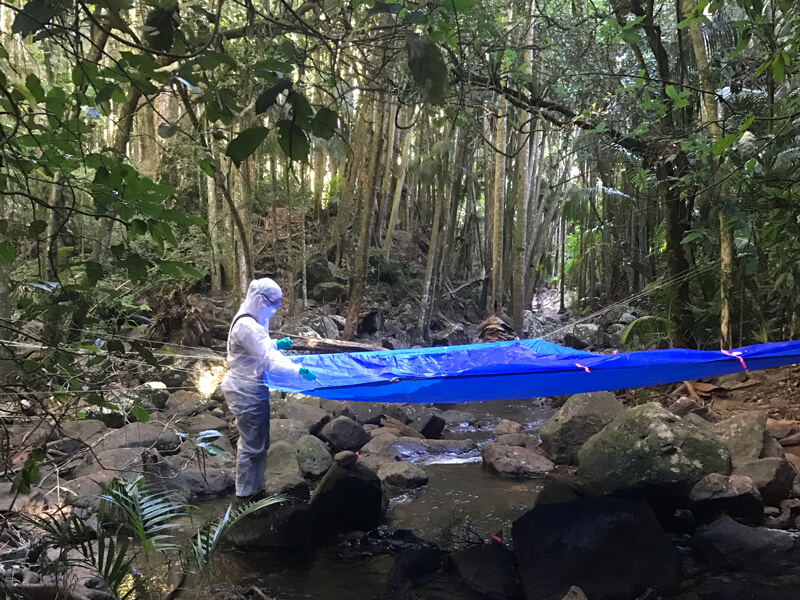
There may be insights to gather from other animals that tolerate disease-causing pathogens, too. Mandl has found that sooty mangabey monkeys, which carry but aren’t sickened by a close relative of HIV called simian immunodeficiency virus, also have a dialed-back interferon response.
And Tony Schountz, a viral immunologist at Colorado State University, says the same sort of thing occurs in the mice, rats and shrews that happily host hantaviruses. “They have this anti-inflammatory immune response to what’s to them a rather innocuous virus,” he says. “In people, there’s this massive inflammatory response that occurs; it’s thought that that’s the principal contributor to the disease and the death of humans.”
Understanding these “successful” immune responses, Schountz adds, could one day lead to strategies to mitigate disease severity in people. Say, for example, you knew what parts, or which molecules, of the immune system need to be tamped down to avoid inflammation when a virus infects. Then “you could develop a therapy or drug that can disrupt that pathway to prevent the inflammatory response from occurring,” he suggests.
The study of bats has more immediate — and urgent — goals, though. “It’s really important to study bats in nature, to understand where the viruses are so that we can try to understand why they are coming from those populations and killing people,” says epidemiologist David Hayman of Massey University in New Zealand, who wrote an overview on bats and viruses in the Annual Review of Virology.
Given the outbreaks that have been linked to bats in recent years — several coronaviruses, Hendra, Nipah, Ebola, Marburg and many more — he and other infectious-disease researchers say it’s of paramount importance to understand the likelihood of future spillover events. The question warrants addressing from several angles.
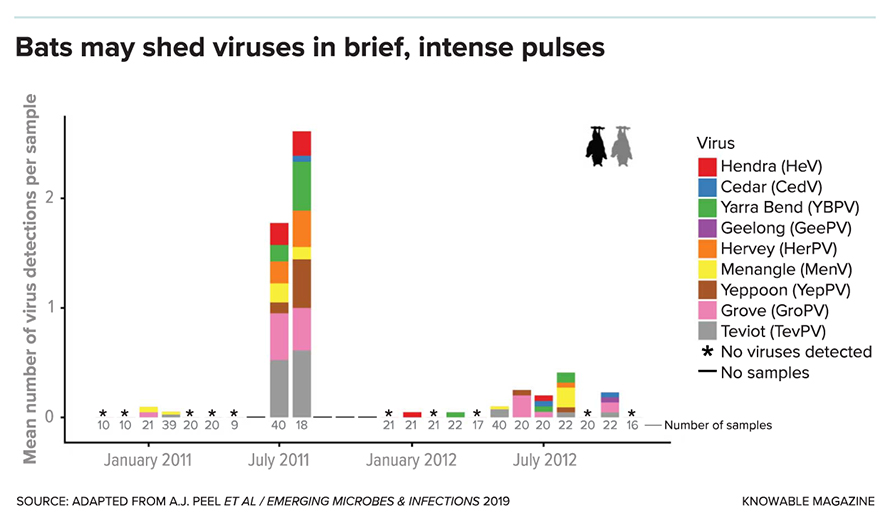
The type of virus involved clearly matters. Many of the high-consequence ones that have made the jump from bats to people in recent years use RNA as their genetic material. The machinery used by many of these viruses to copy their genomes is particularly sloppy, which means that errors — new mutations — can quickly accrue, raising the odds of hitting upon mutations that allow the virus to switch hosts. (Coronaviruses aren’t as sloppy as some, but still accumulate changes by frequently trading chunks of genome back and forth.)
Also important are the types of human-bat interactions: Which ones are the most risky? “If you think about coronaviruses, they are found in bats all over the world,” Hayman says. “So another way of looking at this is: Why don't all those infections cause outbreaks?”
Recent research suggests that stress is important — it may be a key predictor of bats shedding lots of virus. Plowright has spent years capturing bats in giant nets and sampling their blood, urine and feces, and finds that viral infections in bats are not consistent across time and space. In fact, much of the time, viruses can’t be detected at all.
“We’ll look again and again, over and over, and we won’t find anything,” she says. “And then we’ll come back the next month and sample again, and we might find a large proportion of the bats are actually infected with the virus.”
Those obvious infections may last a couple of months, then disappear. In the flying foxes of Australia, peak periods of infection — which coincide with Hendra virus spillover events — occur during the birthing season. Other types of stress, such as food shortages or habitat loss, also may drive periods of viral shedding. Hayman and colleagues have found that land use changes in West Africa — resulting in fragmentation of the forests in which bats live — coincide with outbreaks of Ebola.
Stress aside, increased contact itself is problematic. “Just the simple fact of more people, more habitat destruction, means more potential contacts, which may just simply increase chances of an infection,” Hayman says.
Trying to eliminate such encounters by eliminating bats is not the answer, experts stress. “That would be a disaster,” Plowright says. “They provide huge ecosystem services.” Bats are crucial pollinators of hundreds of plants including many agriculturally important ones. They aid in seed dispersal, and many are voracious eaters of insects — mosquitos and crop pests importantly among them. And eliminating bats can backfire, with deadly consequences: Killing Egyptian fruit bats in a mine in Uganda led to an influx of new bats and a Marburg virus outbreak, scientists think.
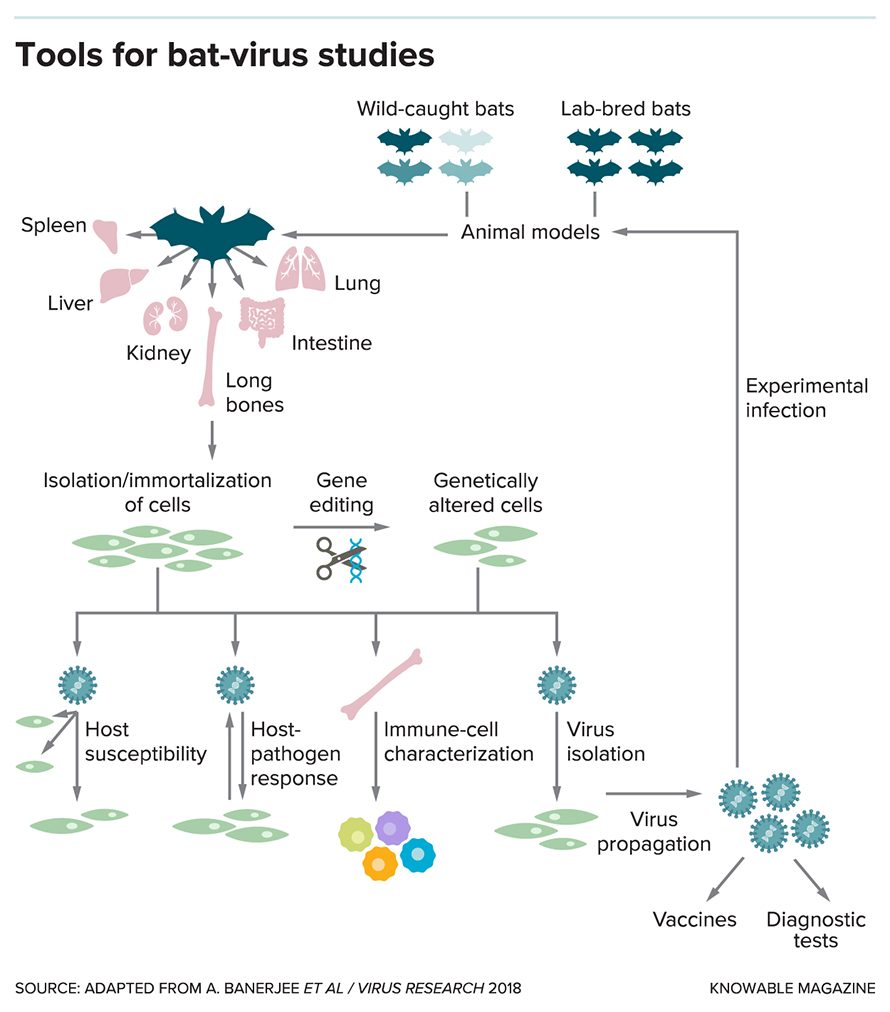
Scientists know they’ve only just begun to parse the relationship between bats and the medley of viruses they harbor, as well as the whys and wherefores of those occasional, catastrophic viral crossovers into our own species. Other features of bats, such as the close-quarter colony living of many species and the extremely low body temperatures of hibernation, also may play key roles in bat-virus dynamics.
There is much work to do, much of it difficult. Even straightforward experiments can be tricky because lab protocols and reagents have been tailored for human tissues and mice, not chiropterans. With the Covid-19 pandemic roiling on, scientists have expressed dismay and astonishment at the recent termination of funding for bat and coronavirus research by the National Institutes of Health. But they are pushing ahead with their work.
Banerjee, for his part, finds himself yet again suited up hazmat-style and scrupulously swapping out shoes at day’s end. He spends his hours nurturing petri dishes of bat kidney cells and growing up flask gardens of virus, then combining the two for infection experiments, a version of nature’s bat-virus détente writ small.
For the time being, he’s focused on SARS-CoV-2, but still as a bat guy, now as a postdoc at McMaster University in Ontario. “I thought grad school was busy,” he says. “But this is insanely busy.”
This article originally appeared in Knowable Magazine, an independent journalistic endeavor from Annual Reviews. Sign up for the newsletter.
Enjoy reading ASBMB Today?
Become a member to receive the print edition four times a year and the digital edition monthly.
Learn moreGet the latest from ASBMB Today
Enter your email address, and we’ll send you a weekly email with recent articles, interviews and more.
Latest in Science
Science highlights or most popular articles

Bacteriophage protein could make queso fresco safer
Researchers characterized the structure and function of PlyP100, a bacteriophage protein that shows promise as a food-safe antimicrobial for preventing Listeria monocytogenes growth in fresh cheeses.

Building the blueprint to block HIV
Wesley Sundquist will present his work on the HIV capsid and revolutionary drug, Lenacapavir, at the ASBMB Annual Meeting, March 7–10, in Maryland.

Gut microbes hijack cancer pathway in high-fat diets
Researchers at the Feinstein Institutes for Medical Research found that a high-fat diet increases ammonia-producing bacteria in the gut microbiome of mice, which in turn disrupts TGF-β signaling and promotes colorectal cancer.

Mapping fentanyl’s cellular footprint
Using a new imaging method, researchers at State University of New York at Buffalo traced fentanyl’s effects inside brain immune cells, revealing how the drug alters lipid droplets, pointing to new paths for addiction diagnostics.

Designing life’s building blocks with AI
Tanja Kortemme, a professor at the University of California, San Francisco, will discuss her research using computational biology to engineer proteins at the 2026 ASBMB Annual Meeting.

Cholesterol as a novel biomarker for Fragile X syndrome
Researchers in Quebec identified lower levels of a brain cholesterol metabolite, 24-hydroxycholesterol, in patients with fragile X syndrome, a finding that could provide a simple blood-based biomarker for understanding and managing the condition.

